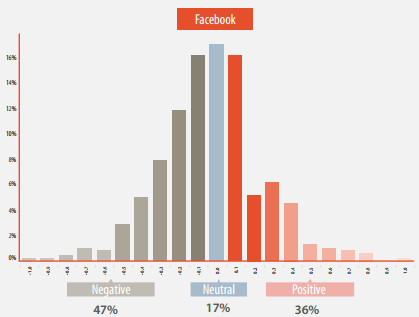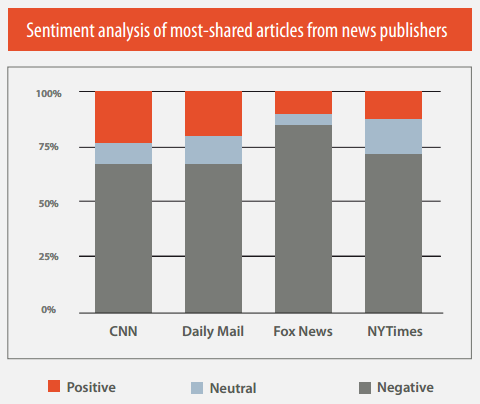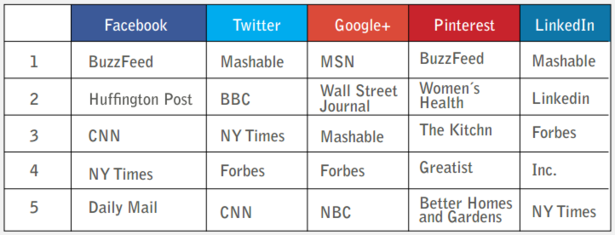It’s the Fractl data I wanted to delve into in more depth in this post.
The report: Which publishers are winning at social engagement? not only looks into which networks are winning in the sharing stakes and which publishers produce the most popular content, but also how the emotional sentiment of the content has an impact on how far it travels.
Headlines to stories shared on Facebook skew towards negative, rather than uplifting positive content
With Facebook dominating the global social media market as it does, it is unsurprising that the network also sees the most content shared compared to other channels. From Fractl’s study of 2.18b article shares across five social networks, 81.9% occur on Facebook.
In terms of content sentiment, 47% of the article headlines shared on Facebook were considered to be negative and 17% neutral. 36% were said to be positive.

And this is not the same for all the networks studied. Fractl concluded that the emotional landscape of Pinterest and LinkedIn was the most positive, while that of Twitter and Google+ had the widest range of sentiments shared.
News publishers are key sharers of negative content
Fractl highlights a certain trend among news publishers in particular. The content shared by CNN, Daily Mail, Fox News and New York Times is overwhelmingly negative.
None of these publishers produce even 25% of positive content for sharing online. The amount of negative headlines varies from around 70% for CNN and 80% for Fox News.

In comparison, Buzzfeed and Upworthy, both key content publishers on Facebook, see at least 50% of the content they produce deemed neutral.
So does negativity mostly beat positivity on social?
Of course the answer is not clear cut, but thankfully not so depressing either. Although news sources are prevalent across all the social networks analysed.
Facebook for example sees its top two publisher spots falling to Buzzfeed and Huffington Post.

Additionally, a look at the most shared articles across these networks sees largely neutral headlines, such as ‘The 9 Oddest Job Interview Questions Asked at Tech Companies in 2011’ and ‘What Kind Of Dog Are You’ leading the pack.
In the least, these stats are surprising and offer an interesting angle to respond and approach to consuming and sharing stuff on social networks. Initially, I was surprised that the amount of content which gets shared is negative, despite having always assumed such content is more clickable.
For those looking to compete with the winning publishers across Facebook, Twitter and Google+, knowledge of the differences between popular types of content seen on these networks, and that a variety of emotionally diverse articles can succeed is valuable.
But if your happy, bubbly, uplifting posts just aren’t engaging the way you’d like, perhaps now it’s easier to see why.






















No Comments